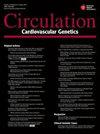多标记遗传风险评分用于预测冠心病事件的临床应用:一项超过51000名欧洲血统个体的队列研究
Q Medicine
引用次数: 48
摘要
背景:我们评估了将多位点遗传风险评分(GRSs)纳入Framingham风险方程是否能提高无症状个体对冠心病(CHD)风险的预测能力、区分和重新分类。方法和结果:我们对北加州综合医疗保健系统的51 954名欧洲血统成员进行了一项队列研究(67%为女性;平均年龄59岁)无冠心病(2007-2008)。使用8到51个先前确定的遗传变异构建了4个grs。在平均(±SD) 5.9(±1.5)年的随访后,记录了1864例冠心病事件。在经个体危险因素调整的模型中,所有GRSs与冠心病呈线性相关:每SD单位的风险比(95%置信区间):GRS_8为1.21 (1.15-1.26),GRS_12为1.20 (1.15-1.26),GRS_36为1.23 (1.17-1.28),GRS_51为1.23(1.17-1.28)。GRSs的加入提高了GRS_8和GRS_36的C统计量(&Dgr;C统计量=0.008;GRS_12为0.007;GRS_51为0.009;所有P < 0.001)。在整个队列中,GRS_8、GRS_12和GRS_36的净重分类改善率为5%,GRS_51的净重分类改善率为4%,在校正偏倚后,在分析被归类为中间Framingham风险(10%-20%)的人群时,GRS_8和GRS_12的净重分类改善率为9%,GRS_36和GRS_51的净重分类改善率为7%。根据遗传信息选择性地使用他汀类药物上分类受试者后,预防1例冠心病所需的治疗数量为GRS_8和GRS_12为36例,GRS_36为41例,GRS_51为43例。结论:我们的研究结果表明,在欧洲血统的受试者中,4个多位点GRSs对冠心病事件具有显著的和临床相关的增量判别/预测能力。本文章由计算机程序翻译,如有差异,请以英文原文为准。
Clinical Utility of Multimarker Genetic Risk Scores for Prediction of Incident Coronary Heart Disease: A Cohort Study Among Over 51 000 Individuals of European Ancestry
Background—We evaluated whether including multilocus genetic risk scores (GRSs) into the Framingham Risk Equation improves the predictive capacity, discrimination, and reclassification of asymptomatic individuals with respect to coronary heart disease (CHD) risk. Methods and Results—We performed a cohort study among 51 954 European-ancestry members of a Northern California integrated healthcare system (67% female; mean age 59) free of CHD at baseline (2007–2008). Four GRSs were constructed using between 8 and 51 previously identified genetic variants. After a mean (±SD) follow-up of 5.9 (±1.5) years, 1864 incident CHD events were documented. All GRSs were linearly associated with CHD in a model adjusted by individual risk factors: hazard ratio (95% confidence interval) per SD unit: 1.21 (1.15–1.26) for GRS_8, 1.20 (1.15–1.26) for GRS_12, 1.23 (1.17–1.28) for GRS_36, and 1.23 (1.17–1.28) for GRS_51. Inclusion of the GRSs improved the C statistic (&Dgr;C statistic =0.008 for GRS_8 and GRS_36; 0.007 for GRS_12; and 0.009 for GRS_51; all P<0.001). The net reclassification improvement was 5% for GRS_8, GRS_12, and GRS_36 and 4% for GRS_51 in the entire cohort and was (after correcting for bias) 9% for GRS_8 and GRS_12 and 7% for GRS_36 and GRS_51 when analyzing those classified as intermediate Framingham risk (10%–20%). The number required to treat to prevent 1 CHD after selectively treating with statins up-reclassified subjects on the basis of genetic information was 36 for GRS_8 and GRS_12, 41 for GRS_36, and 43 for GRS_51. Conclusions—Our results demonstrate significant and clinically relevant incremental discriminative/predictive capability of 4 multilocus GRSs for incident CHD among subjects of European ancestry.
求助全文
通过发布文献求助,成功后即可免费获取论文全文。
去求助
来源期刊

Circulation-Cardiovascular Genetics
CARDIAC & CARDIOVASCULAR SYSTEMS-GENETICS & HEREDITY
CiteScore
3.95
自引率
0.00%
发文量
0
期刊介绍:
Circulation: Genomic and Precision Medicine considers all types of original research articles, including studies conducted in human subjects, laboratory animals, in vitro, and in silico. Articles may include investigations of: clinical genetics as applied to the diagnosis and management of monogenic or oligogenic cardiovascular disorders; the molecular basis of complex cardiovascular disorders, including genome-wide association studies, exome and genome sequencing-based association studies, coding variant association studies, genetic linkage studies, epigenomics, transcriptomics, proteomics, metabolomics, and metagenomics; integration of electronic health record data or patient-generated data with any of the aforementioned approaches, including phenome-wide association studies, or with environmental or lifestyle factors; pharmacogenomics; regulation of gene expression; gene therapy and therapeutic genomic editing; systems biology approaches to the diagnosis and management of cardiovascular disorders; novel methods to perform any of the aforementioned studies; and novel applications of precision medicine. Above all, we seek studies with relevance to human cardiovascular biology and disease. Manuscripts are examined by the editorial staff and usually evaluated by expert reviewers assigned by the editors. Both clinical and basic articles will also be subject to statistical review, when appropriate. Provisional or final acceptance is based on originality, scientific content, and topical balance of the journal. Decisions are communicated by email, generally within six weeks. The editors will not discuss a decision about a manuscript over the phone. All rebuttals must be submitted in writing to the editorial office.
 求助内容:
求助内容: 应助结果提醒方式:
应助结果提醒方式:


